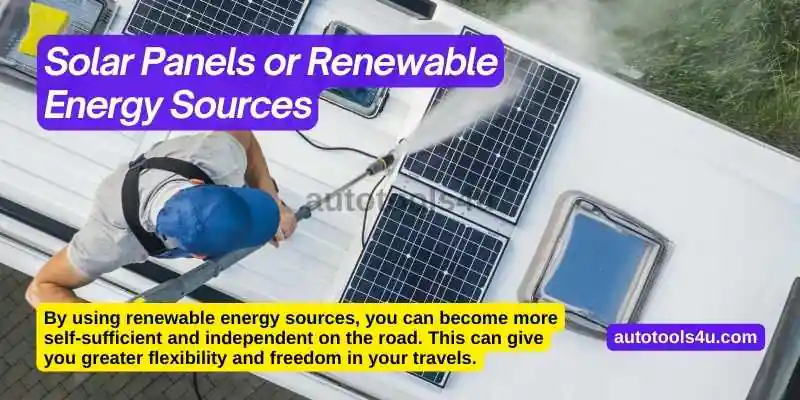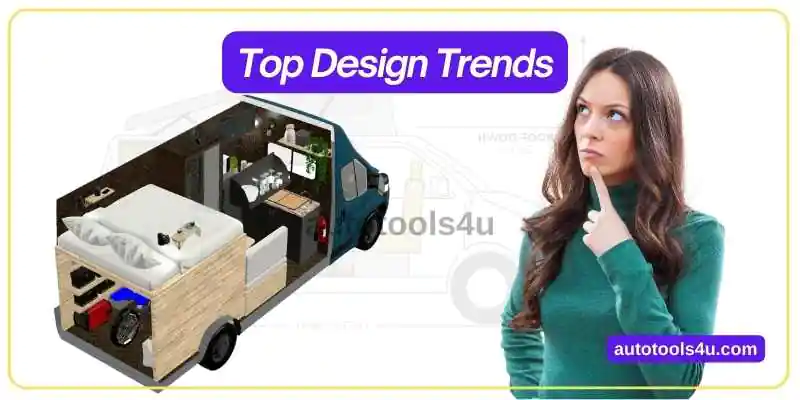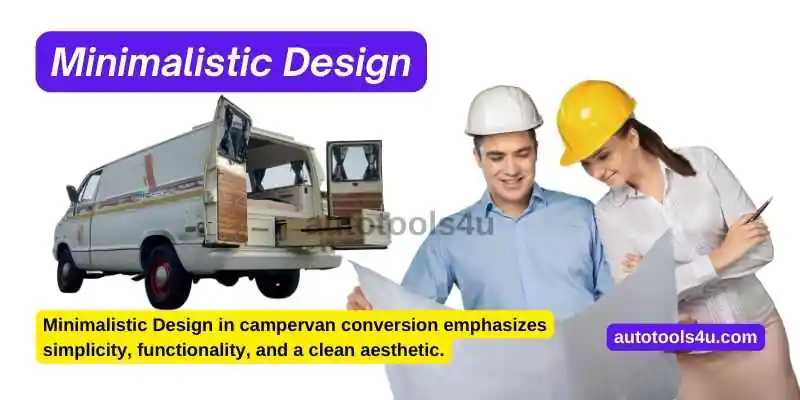Campervan conversions is an idea never too old or outdated to discuss. It has become even more relevant nowadays because of the pressure of urbanization and the resulting drive to become free and live an independent lifestyle. We shall below discuss some of the ideas which are very relevant these days. Some of these ideas will be essentially over-the-top feel for you which would make sense because everyone has their own feelings about how the space they own should look like.
Campervan conversions – Minimalistic Design
Minimalistic Design in campervan conversion emphasizes simplicity, functionality, and a clean aesthetic. Focus on simplicity in design with a clean, modern look and the essential amenities for a comfortable living experience, such as a bed, kitchenette, and bathroom facilities.
- Use light, neutral color sheds, hidden storage solutions, and minimal decor to create a spacious and calming atmosphere.
- Integrate technology, such as lighting, heating, and entertainment systems, into the design in a discreet manner.
- Use space-saving furniture, such as a fold-down bed or table, to maximize the available living space
Use natural materials, such as wood, stone, and linen, to create a warm and inviting atmosphere. Incorporate simple lighting solutions, such as LED strips or overhead lamps, to create a functional and well-lit living space.
Campervan conversions – Sustainable Features:
Use of eco-friendly materials and technology such as solar panels, composting toilets, and water filtration systems. Sustainable features in campervan conversion aim to reduce the environmental impact of the vehicle and increase self-sufficiency on the road. you can Implement water filtration systems and gray water tanks to collect and reuse water and Install solar panels on the roof of the campervan to provide renewable energy for lights, appliances, and electronics. Install a composting toilet to reduce the need for chemical waste disposal and conserve water.
- Use energy-efficient appliances, such as LED lights and low-power fridges, to reduce the energy consumption of the campervan.
- Use eco-friendly materials, such as bamboo or recycled plastics, in the construction of the campervan.
Recycling Solutions: Include recycling solutions, such as composting bins or recycling containers, to minimize waste. Upgrade the insulation of the campervan to reduce the need for heating and cooling, and improve energy efficiency.
Campervan conversions – Versatile Layout:
A versatile layout in campervan conversion allows for multiple functions in a limited space. This idea is based on and around multi-functional spaces that can be transformed from a bed to a dinette, office, or lounge area. You can choose to use modular furniture, such as a convertible bed or dinette, that can be reconfigured into different configurations or folding or sliding components, such as a pull-out bed or table, to maximize the use of available space. Create multi-purpose areas, such as a workstation that can double as a dining table, to increase the functionality of the living space.
- Implement adaptable storage solutions, such as overhead or under-bed storage, to maximize the use of available space.
- Include built-in amenities, such as a sink or stove, to reduce the need for bulky and space-consuming appliances.
One idea is to Integrate hidden features, such as a pop-up roof or fold-out awning, to expand the living space when needed and using lightweight and durable materials, such as aluminum or composite, to reduce the weight of the campervan and increase its versatility.

Campervan conversions – Smart Technology:
Smart technology in campervan conversions integrates modern technologies to enhance the functionality and convenience of the living space. A few examples of this would be the Integration of smart home technology, such as voice-activated controls, automated systems, and built-in Wi-Fi. You can start by Implementing a smart energy management system to monitor and control the consumption of electricity, battery power status, and other resources. Use remote monitoring and control systems, such as a smartphone app, to manage the various systems in the campervan, such as lighting, heating, and cooling. Also, another thought is to Integrate smart home automation systems, such as voice-controlled devices or smart lighting, to control the various features of the campervan. You may install navigation and entertainment systems, such as a GPS, Satnav, or multimedia system, to enhance the road trip experience.
- Incorporate wireless charging solutions, such as built-in charging pads, to simplify the charging of devices.
- Implement smart security systems, such as alarms, cams, or surveillance systems, to secure the campervan and its contents.
Campervan conversions – Increased Comfort:
Improving insulation, heating, and ventilation systems in a campervan conversion can significantly enhance the comfort of the living space. You can upgrade the insulation of the campervan, using materials such as foam or fiberglass, to reduce heat loss and improve energy efficiency and install a heating system, such as a diesel heater or a propane furnace, to provide warmth in cold climates.
- Implement a ventilation system, such as a roof fan or air vents, to vent harmful gases, circulate fresh air, and improve air quality in the living space.
- Soundproof the campervan, using materials such as acoustic foam or mass-loaded vinyl, to reduce road noise and improve sound quality.
- Install comfort lighting, such as LED lights or dimmers, to improve the ambiance and functionality of the living space.
- Use comfortable floorings, such as carpet or cork, to enhance the foot comfort and warmth of the living space.
Campervan Conversion – Off-Road Capabilities:
Off-road capabilities extensions for a campervan conversion enhance the vehicle’s ability to navigate rough terrain and handle outdoor adventures. It will significantly add value to your vehicle in reality as it increases your range to gain access to areas and sections which you wouldn’t be able to access before. You can start by upgrading the suspension of the campervan, using components such as coil-overs, to improve stability and handling on rough terrain. Install all-terrain tires, with improved traction and durability, to handle rough terrain and mud and Implement underbody protection, such as skid plates or bash plates, to protect the campervan from rocks and debris.
- Install high-clearance suspensions, such as a lift kit or body lift, to increase ground clearance and improve off-road capability.
- Convert the campervan to a 4×4 drivetrain, to improve traction and stability on rough terrain.
- Install roof-mounted equipment, such as a roof rack or a roof tent, to expand the living and storage space of the campervan.
- Install off-road navigation equipment, such as a GPS tracker or a compass, to enhance the ability to navigate rough terrain.
Campervan Conversion – Storage optimization
Optimizing and increasing internal storage in a campervan conversion can help to maximize the use of the limited space in the vehicle and keep the living area clutter-free. Using foldable furniture, such as a drop-down bed or a fold-out table, can increase the available storage space and minimize the footprint Installing built-in cabinets and drawers, using materials such as plywood or MDF, to maximize the use of the vertical space in the campervan.
- Install overhead storage, such as a shelf or a net, to increase the use of the ceiling space and store items out of the way.
- Compartmentalize the storage, using containers or bins, to keep items organized and easy to access.
- Use modular storage systems, such as a pegboard or a rail system, to customize the storage according to your needs.
- Incorporate hidden storage, such as under-bed drawers or seat compartments, to store items out of sight and free up valuable floor space.

Campervan Conversion – Renewable Energy Harnessing
Using standalone solar panels and wind turbines for a campervan conversion can provide an eco-friendly and self-sufficient power source for the vehicle. Wind turbines especially could be potentially difficult to handle and install but there are few specialist companies that are working towards the design and manufacturing of portable wind turbines. Here are some ideas for optimizing the use of standalone solar panels and wind turbines in a campervan conversion:
- Solar Panel Placement – Optimal placement of the solar panels is crucial for maximizing efficiency, and it is recommended to place them on a flat surface with a southern exposure.
- Install as bigger as possible battery bank, connected to the solar panels, to store the energy generated by the panels and provide power to the campervan electrical systems.
- Use a charge controller, connected between the solar panels and the battery bank, to optimize the charging of the batteries and prevent overcharging.
- Install an inverter, connected to the battery bank, to convert the stored DC power into AC power and supply power to the campervan electrical appliances.
- Optimal placement of the wind turbine is crucial for maximizing its efficiency, and it is recommended to place it on a tall, unobstructed surface, such as a mast or a tower.
- Diversify the power sources, by combining the use of solar panels and wind turbines, to ensure a reliable and consistent power supply.
Campervan Conversion – Smart Battery Revolution
Using smart lithium batteries on a campervan conversion can provide several advantages over conventional batteries and can improve the comfort and functionality of the vehicle. Here are some ways smart lithium batteries can improve the comfort of a campervan conversion:
- Lithium batteries are much lighter than traditional lead-acid batteries, reducing the weight of the vehicle and improving fuel efficiency.
- Lithium batteries have a higher energy density, providing more power per unit of weight, and enabling the use of more electrical appliances and systems in the campervan.
- Lithium batteries have a longer lifespan than traditional batteries, reducing the need for frequent replacements and increasing the durability of the power system.
- Lithium batteries can be charged faster than traditional batteries, reducing the time needed to fully charge the batteries and increasing the availability of power.
- Lithium batteries require lower maintenance than traditional batteries, reducing the time and effort needed to keep the power system in good working condition.
FAQ – CamperVan Conversion
Are motorhomes/Campervan conversions worth it at all?
Whether a motorhome or campervan conversion is worth it depends on your individual circumstances, needs, and preferences. Here are some factors to consider.
One of the advantages of a motorhome or campervan conversion is the ability to customize it to meet your specific needs and preferences. If you’re willing to put in the time and effort to create a custom space, it may be worth it. Also, If you plan to sell your motorhome or campervan in the future, it’s important to consider the potential resale value. A well-maintained and updated motorhome or campervan can hold its value well, making it a worthwhile investment.
- If you plan on using your motorhome or campervan frequently, the cost may be worth it. On the other hand,
- Motorhomes and campervan conversions can be expensive, so it’s important to consider your budget before making a purchase.
Is using Solar panels or renewable energy sources in your Campervan or Motor home a good idea?
Using solar panels or other renewable energy sources can help you save money on energy costs while on the road. Instead of relying solely on traditional fuel sources, you can harness the power of the sun or wind to generate electricity. By using renewable energy sources, you can reduce your carbon footprint and minimize your impact on the environment. This is especially important for those who enjoy spending time in nature and want to protect the natural beauty around them. Solar panels and other renewable energy sources are quiet, reliable, and require little maintenance. This means you can enjoy the benefits of electricity without the hassle of noisy generators or constant refueling. With solar panels or other renewable energy sources, you can enjoy off-grid camping and travel. This means you can explore remote locations without worrying about finding traditional power sources.
- By using renewable energy sources, you can become more self-sufficient and independent on the road. This can give you greater flexibility and freedom in your travels.
- Overall, using solar panels or other renewable energy sources in your campervan or motorhome can be a smart and sustainable choice that provides many benefits.
What are the benefits of using smart Lithium batteries as opposed to Lead acid batteries in your Campervan?
Lithium batteries are much lighter and more compact than lead-acid batteries. This means you can save space and weight in your campervan, allowing you to carry more gear or travel more efficiently. Lithium batteries have a longer lifespan than lead acid batteries, which means you’ll need to replace them less often. In fact, some smart lithium batteries can last up to 10 years or more. Lithium batteries have a higher energy density than lead-acid batteries, which means they can store more energy in the same amount of space. This makes them more efficient and powerful, allowing you to power more devices or run your campervan for longer periods of time. Also, Lithium batteries can be charged much more quickly than lead acid batteries. This means you can recharge your batteries more efficiently and get back on the road sooner.

